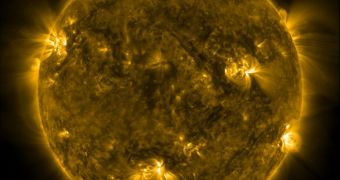New datasets secured by the NASA Solar Dynamics Observatory (SDO) appear to indicate that the overall strength and longevity of solar flares is now increasing more than first calculated. At this time, experts are trying to understand why this is happening.
In order to conduct such precise investigations, SDO is using its Extreme ultraviolet Variability Experiment (EVE) instrument. The tool can observe the radiation of solar flares for prolonged periods of time, even after the main event has theoretically subsided.
The flares themselves are nothing more than intense radiation bursts produced when the magnetic energy of sunspots is released. They represent the most powerful class of explosions that may take place on the Sun, solar physicists say.
The reason why analyzing them is so important is because their influence can extend all the way to Earth's surface, despite the protective effect of the magnetosphere. Solar flares can harm satellites, disrupt communications and affect power grids.
Since its launch, SDO has been keeping a constant eye on our parent star. It managed to discover that all flare events have extended phases that may last up to 5 hours after the main event reaches peak intensity. At times, the later phase has more energy than its predecessor.
“Previous observations considered a few seconds or minutes to be the normal part of the flare process. This new data will increase our understanding of flare physics and the consequences in near-Earth space where many scientific and commercial satellites reside,” Lika Guhathakurta explains.
The expert holds an appointment as the lead program scientist of the Living with a Star Program, at NASA Headquarters in Washington, DC. He says that SDO's capabilities proved very important during a solar flare that was produced on November 3, 2010.
If the telescope had not detected the secondary stage of the flare, then solar physicists would have underestimated the amount of radiation making its way to Earth by as much as 70 percent, NASA says.
“For decades, our standard for flares has been to watch the X-rays as they happen and see when they peak. But we were seeing peaks that didn't correspond to the X-rays,” adds University of Colorado in Boulder (UCB) space scientist Tom Woods.
He is the principal author of a new paper detailing the findings, which is published in the September 7 online issue of the esteemed Astrophysical Journal. The expert says that EVE's data are complemented by readings from the SDO Advanced Imaging Assembly (AIA), the telescope's second instrument.

 14 DAY TRIAL //
14 DAY TRIAL //